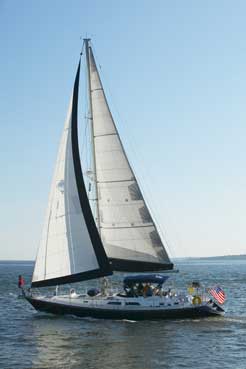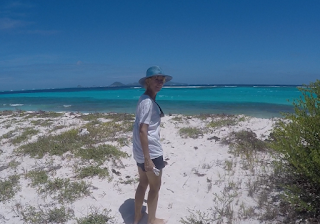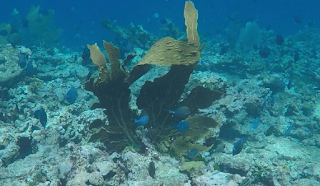We left Grenada around 11:00 March
19th and headed for Tyrrel Bay Carriacou. We were able to sail there in 4 hours tacking
into the harbor from about 5 miles out. We
grabbed a mooring and dingied in to shore.
Eilo was able to scoop some local vegetables. They turned out to be better than the store
bought veg we sourced in Grenada:
We carried the boat papers
and passports as our main purpose for going to Carriacou (other than we like
the name) is to formally Clear Out of Grenada enabling us to Clear Into St.
Vincent and the Grenadines. This border
control stuff the ARC takes care of for all border entry/exits except when free
sailing – as we are currently doing. The
process takes a little time – but not to do it will usually take a
significantly longer period of time and $$$ to sort out. After lunch in a beach bar with Sandvita we
walked up the shore to Customs and Immigration who were all very nice and cleared
us out. TULLA MHOR just arrived and
dinghied over to AURORA to say goodbye with the proviso we would all catch-up in
Bequia. There was about 8 knots of wind
when we left, heading for Union Island, and we leveraged that into 5 knots of
boat speed Genoa sailing. The wind died
to about 4 knots after 2 hours necessitating we motor sail that last 2 hours. Arrived Union just behind SANDVITA at 16:00
and found a mooring just off the piers of the main town of Clifton . We had noticed a very small island with a
single building on it as we motored in.
Later we found 1out that 0 years ago it was a pile of conch shells – man
do they eat a lot of conch down here. It
probably looked something like this:
Over time and with no small
level of industry a couple of locals encased the shells in concrete and put a
structure over it, started serving rum punch, and named it Happy Island:
We had to check it out to
ensure it had the correct level of happiness so SANDVITA and AURORA took a
water taxi out about ½ mile to Happy. It
was in shallow water protected by a big reef out another ¼ mile. The reef
provided a large shallow, flat bay with lots of wind – attracting lots of
Kiters. This guy, looking for a takeoff,
obviously did well in his kiting lessons:
You can’t be entertained
these days with-out suffering through a little advertising:
And once you’ve got big
air you might as well get tricky – No?:
Eventually it’s time to start
lookin’ for water:
And ultimately get ready to
plant it:
This all happening just feet
from Happy. We are back in SANDVITA’S
home territory so Lars was busy planning what we should do next. No doubt more sessions on shore. Town has a very well sheltered dinghy
dock. You need to pass under one of 2
foot bridges to get into it. You are
right. It looks dangerous under this
bridge:
… the other bridge is a
little better. We checked out the town –
one of many of their local markets:
We caught up with ALTAIR and
SANDVITA and a few beers later found ourselves in a taxi heading to a place
recommended by Lars a short taxi ride away – Jack Sparrows Beach Bar &
Club. They had their own beach, cold
drinks, and great food. We spent most of
the day toughing it out here:
Then back to our boats to get
ready for diner aboard SANDVITA. Lars cranked
out one of his special Skippers Pie and Eilo baked choco chip cookies for
desert – yum. We drank just enough so we
could be comfortably numb and slightly hung over as we motored a short distance
to the Cays the next morning. The Cays were about 7 miles away so we
couldn’t be bothered to hoist the sails.
These Cays are about 6 deserted islands except the one we moored next to
which had about 3 beach grills/bbq establishments and an equal number of bars
serving drinks out of coolers – very plush.
Reminded us of Foxy’s 30 years ago:
The water is very clear and
the snorkeling was good. One of the
islands is famous for it’s sea turtles so we had to check that out:
Lars hired a water taxi and
said vessel delivered us to a little deserted island called Le Petit Tabac. We brought lunch and plenty of cold beer and
other stuff to keep us alive. It was
weird watching the water taxi disappear after yelling out he would be back to
pick us up next week:
So we sucked it up and made
the best of it. Eilo exploring the ocean
side of Le Petit Tabac:
She then hooked up with another
exploration party to check out the quiet side of the island, probably searching
out suitable space to build shelters so we can await the return of the water
taxi in comfort:
An action shot of Eilo
training for some race or other:
There is a reef about 150
meters off the beach so we checked that out.
Clear water but not too much fishy action or live coral:
It was with great relief when
a vessel was spotted in the direction of the setting sun. Was it coming our way? A 2 minutes group consensus determined the
answer to be affirmative. We were
saved. We cleaned the place up and were
gone with-in a half hour.
The next night AURORA hosted
a sundowner cocktail party on our nearby deserted beach. It was good fun. We burned another sunset with spirited aid
from the crews of TULAMHOR, SANDVITA, ALTAIR and the OWL:
The following night we had a
tremendous lobster dinner arranged by SANDVITA.
The lobsters were probably the best we had ever had and the crew from several
boats were in fabulous form. Just
another Caribbean night!!!
We had forgot how wonderful
sailing the Caribbean was. We always
love the visual rewards:
AURORA spent an extra night
in the Cays and set sail the next day for Chatham Bay on Union Island. There we anchored off the beach close to
Vanessa and Seckie’s bar/restaurant.
They are friends of Lars and
Anne’s and were ready to cook
us yet another feast. Another great
night was had with SANDVITA, TULLA MHOR, ALTAIR AND OWL.
The good ship AURORA elected
to sail to Mayreau the next morning as Mustique was closed – it being close to
Easter and some of the Royal Family (UK) was on vacation at their estate
there. We sailed to Mayreau in 4 hours
and grabbed a mooring in front of some sort of resort and proceeded to tough it
out – yet again:
After a respectable set of
sundowners then diner on shore we crashed out heavy. On awaking we found ourselves restless so we
decided to set off for Bequia and relax there for 5 nights. How can you not like the flag of Bequia?:
We were able to sail about
half way there before the wind died so we motor sailed the last 12 miles. On the way in to Port Elizabeth Harbor we
passed some really weird architecture.
As it turns out a 1960 Mad Man (as in NYC) retired, moved to Bequia,
bought a 30 acre rock peninsula with a natural arch going into the sea and
built his house “Moon Hole” under it. Years
and many additional stone structures late his bizarre Moon Hole resort was
opened – but this is more like Fred Flintstone land as none of the houses or
other resort structures have any windows or doors. Apparently 4 of the resort structures are
still in use as rentals, the rest being privately owned on the 30 acre property:
Eilo had organized one
of Phat Shag’s moorings earlier in the
day and he delivered a fine mooring with
a nice view:
… just in front of town. We chilled for 5 nights as planned in that
wonderful place. We mostly hung around
town frequenting Papas. Lars and Anne’s
favorite Bar and Restaurant overlooking the Port Elizabeth Harbor (they had
their wedding feast prepared by Papa’s).
Had quite a few drinks and meals there.
Lars even organized a pig roast there at Papas for the fleet boats who
had gathered before our final run up to Saint Lucia and the finish line. The roast was excellent – 39 soles from the
fleet attended that informal affair. I
am proud to report no one was asked to leave.
The next day we took another break and dinghied up to the Princess
Margaret Beach for a relaxing afternoon.
In the background – the Bequia Easter Regata was on-going for the 5 days
we were there and start and stops of
most races could be seen from AURORA:
On Apri; 4th most
of the fleet boats left for Marigot Bay Saint Lucia about 60 miles away. We were able to sail most of the way and
arrived in at 4:00 on the afternoon of April 4ht and cleared in. It’s a beautiful marina/resort so we got back
to the serious business of chillin’. We
are only 9 miles from the finish line.
On Saturday the 7th all the boats dressed will motor up to
the finish line at Rodney Bay. It’s now April
7th – the last day of this WARC.
I just walked the dock and the fleet is looking good. We get briefed at 9:15 re protocol for this “follow
the leader” parade of sails (smallest boat to largest) – motoring the last 9.1
miles to Rodney Bay. We cast off around
10:00 and rapidly rapped the bow line from the boat beside us around AURORA’s
prop… so Captain Ken got back into his snorkeling gear and in about 10 minutes
was able to unwrap the prop with the help of Captain Thomas from Hannah. Lucky there was no wind in the harbor so the
marina dinghy was able to hold our position…
And we got out of there with-out crashing anything except our
dignity… leaving Marigot Bay and Dr.
Doolittles to stern. It transpired that
the original Dr. Doolittle was filmed here and that has been leveraged into a
resort. On the other side of this beach
the scene with the pink snail floating was filmed “a few” years ago.
After a parade of sails
(actually flags!):
…. that took us around
Castries harbor and north to Rodney Bay AURORA finally crossed the finish line on April 7th at 14:00 completing a 25,000 mile circumnavigation of our planet:
So what does all this
mean? Yes - one feels a great sense of
accomplishment crossing that finish line.
The world has become a much smaller place to us over the last 15
months. It is a wonderful planet we
live on and is well worth the effort to explore and better understand it. We will miss the WARC Gang but it is also a
relief that it is over. We are confident
that we have made friends for life and so we expect to see the “gang” again and
that makes us happy. We have partied our
way around the world. And we partied
hard like we were back in college except then we had no sense and no money –
now we still have no sense but unfortunately can now afford… The relief comes from NOT having to face
continuous bouts of eating and drinking (not necessarily in that order) whenever
and where ever we were on shore. It took
us 411 gallon of diesel to get around – sailing the whole thing would have been
better but we had to motor days at a time a few times to make schedules or beat
weather. That works out to about 61
miles per gallon – we’ll call that semi-green.
There were no prizes for overall ratings at the final awards diner but
AURORA in 15 legs took 4 firsts, 3 seconds and 3 thirds. Not bad for an old girl. As Eilo says – “The sailing is the easy
part. Keeping the boat together (e.g.
keeping ALL systems functioning) is the hard part”. Believe it!
It has been a great adventure.
The next adventure is Eilo’s – but she is not revealing what that might
be… yet. But that is a future event.
Right now we are looking forward to taking AURORA back to Newport and clear in
to our shore lives!
Be Great & Have Fun.
K&E





























